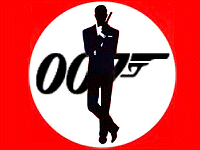


|
 |
|
 |
 |
The first film, Dr.No, was made in 1962 using the basic storyline from creator
and author Ian Fleming's sixth Bond novel and stuck fairly closely to Fleming's
concept of the character, which is also generally true of the first half
dozen or so films before taking on a more 'tongue-in-cheek' approach after
the departure of Connery from the title role. Even so, the nature of the
Bond films utilises the concept of a 'super-villain' or organisation rather
than dealing with the very real, but less entertaining, undercover 'cold
war' espionage of the period. Fleming wrote his first Bond novel, Casino
Royale, in 1953 and produced them at the rate of one a year until his death
in 1964. The original films are very much influenced by Sixties attitudes
with an endless stream of gorgeous women on both the 'good' and 'bad' sides,
all started by Ursula Andress emerging from the sea with a dagger strapped
to her bikini in 'Dr. No', making the 'Bond girl' an instant icon of the
times. In order to maintain the main character's persona of being somewhat
aloof and possessing the confidence of an almost total self-control, Bond
does appear to be somewhat misogynistic but, despite that fact, many of
the powerful characters and roles within the films were female roles and
displayed, to some extent, the expanding liberation of women that was gaining
some momentum during the decade. The characterisations and relationships
within the movies really need to be viewed with this in mind, an understanding
of more relaxed Sixties attitudes and what was then deemed to be acceptable
behaviour. The early films were co-produced by Broccoli and Saltzman on location and at Pinewood Studios, except for Thunderball, which Kevin McClory produced while Broccoli and Saltzman became executive producers. Distribution was handled solely by United Artists until 1981 when they were bought by MGM. Other than the official EON productions, there have been three other films featuring the character of James Bond: a 1954 American 1-hour television movie version of Casino Royale, produced by CBS; a 1967 spoof version of Casino Royale, starring David Niven and produced by Charles K. Feldman and Never Say Never Again, produced by Jack Schwartzman, which reprised Connery in the Bond role in a remake of the Thunderball story. Monty Norman composed the soundtrack for the first film and the main 'James Bond theme' which was actually arranged by John Barry, although he was only credited for the performance itself. Sean Connery was nowhere near being first choice for Bond - Patrick McGoohan (Danger Man) had turned down the part, 'Mr.Universe' Steve Reeves turned it down because it paid only a fraction of his normal salary and Connery was only chosen by the producers in preference to Richard Johnson. Connery had also been a 'Mr Universe' contestant and had won a bronze medal in the lightweight division of the competition in 1955. Despite the varied ways in which the character has been portrayed by a number of excellent actors over the years, for most people it is the image of Connery that springs to the mind of most people, even now, as soon as the name James Bond is mentioned and this has always gone hand-in-hand with the Sixties ideal of fashionable style, from the trilby hats and elegant suits even to the simple beachwear of some scenes - timeless 'class' - which is one characteristic that has been maintained throughout the series of films. There are a number of almost iconic 'features' associated with Bond films, established over the years, threads that run throughout the series regardless of the decade or production 'style' - the highly stylised opening credits for each film, the 'theme song', the main 'James Bond theme', the 'Bond girls', the cars and high-tech gadgets supplied by 'Q' branch and, not least of all, some classic much-quoted dialogue one-liners. 'Do you expect me to talk? No, Mr.Bond, I expect you to die!'. |
 |
 |
 |
 |
 |
 |
 |
|
|
Ian Fleming
|
Albert R. Broccoli
|
Harry Saltzman
|
Kevin McClory
|
Monty Norman
|
John Barry
|
Pinewood
Studios
|
|
|
|
All
Original Material Copyright SixtiesCity
Other individual owner copyrights may apply to Photographic Images |